Analysis of Consumer Behaviour and Decision-Making in Hospitality
VerifiedAdded on 2023/01/19
|12
|3404
|63
Report
AI Summary
This report provides a comprehensive analysis of consumer behavior within the UK hospitality industry. It explores the consumer decision-making process, including pre-purchase, purchase, receive, and post-purchase stages, and examines the factors influencing these decisions. The report differentiates between B2B and B2C hospitality contexts, highlighting the differences in their decision-making processes and the market research methods employed. It evaluates the role of marketers in influencing consumer choices, including the impact of marketing mix elements, and critically assesses theories, concepts, and models that shape hospitality decision-making. The report also discusses the importance of mapping the consumer journey to understand customer needs and preferences. Overall, the report provides valuable insights into consumer behavior within the hospitality sector and the strategies that marketers can use to enhance customer satisfaction and drive business success.
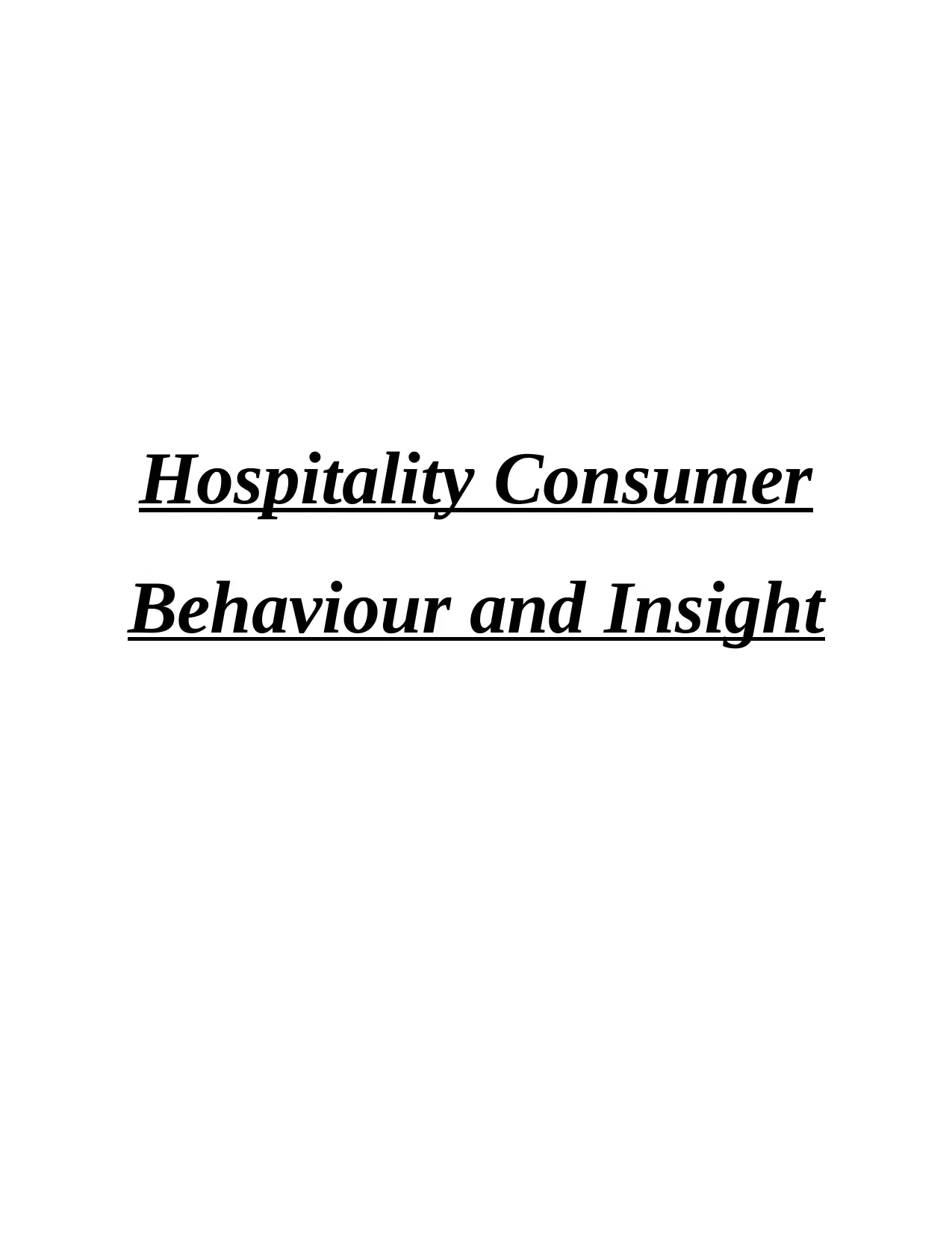
Hospitality Consumer
Behaviour and Insight
Behaviour and Insight
Paraphrase This Document
Need a fresh take? Get an instant paraphrase of this document with our AI Paraphraser
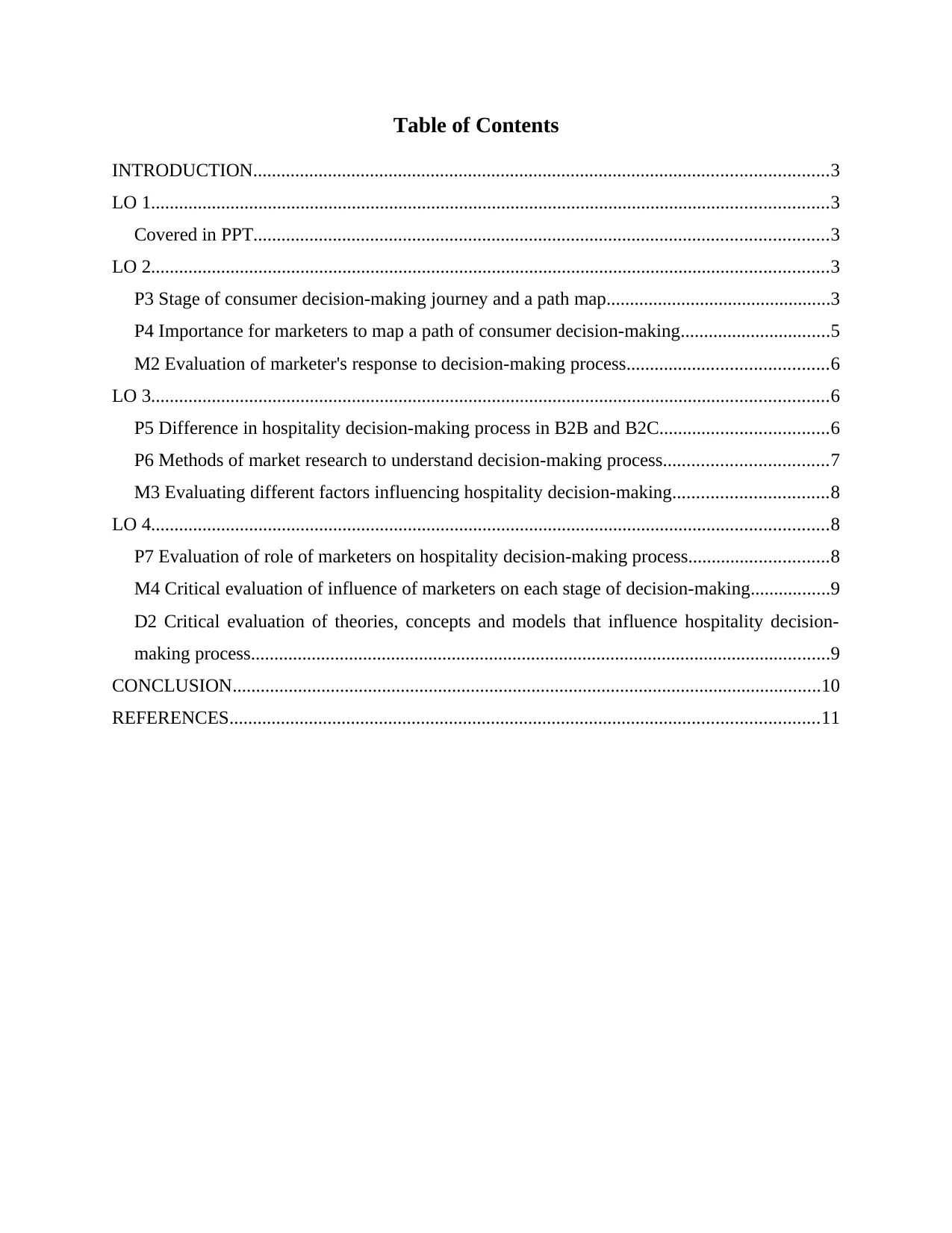
Table of Contents
INTRODUCTION...........................................................................................................................3
LO 1.................................................................................................................................................3
Covered in PPT...........................................................................................................................3
LO 2.................................................................................................................................................3
P3 Stage of consumer decision-making journey and a path map................................................3
P4 Importance for marketers to map a path of consumer decision-making................................5
M2 Evaluation of marketer's response to decision-making process...........................................6
LO 3.................................................................................................................................................6
P5 Difference in hospitality decision-making process in B2B and B2C....................................6
P6 Methods of market research to understand decision-making process...................................7
M3 Evaluating different factors influencing hospitality decision-making.................................8
LO 4.................................................................................................................................................8
P7 Evaluation of role of marketers on hospitality decision-making process..............................8
M4 Critical evaluation of influence of marketers on each stage of decision-making.................9
D2 Critical evaluation of theories, concepts and models that influence hospitality decision-
making process............................................................................................................................9
CONCLUSION..............................................................................................................................10
REFERENCES..............................................................................................................................11
INTRODUCTION...........................................................................................................................3
LO 1.................................................................................................................................................3
Covered in PPT...........................................................................................................................3
LO 2.................................................................................................................................................3
P3 Stage of consumer decision-making journey and a path map................................................3
P4 Importance for marketers to map a path of consumer decision-making................................5
M2 Evaluation of marketer's response to decision-making process...........................................6
LO 3.................................................................................................................................................6
P5 Difference in hospitality decision-making process in B2B and B2C....................................6
P6 Methods of market research to understand decision-making process...................................7
M3 Evaluating different factors influencing hospitality decision-making.................................8
LO 4.................................................................................................................................................8
P7 Evaluation of role of marketers on hospitality decision-making process..............................8
M4 Critical evaluation of influence of marketers on each stage of decision-making.................9
D2 Critical evaluation of theories, concepts and models that influence hospitality decision-
making process............................................................................................................................9
CONCLUSION..............................................................................................................................10
REFERENCES..............................................................................................................................11
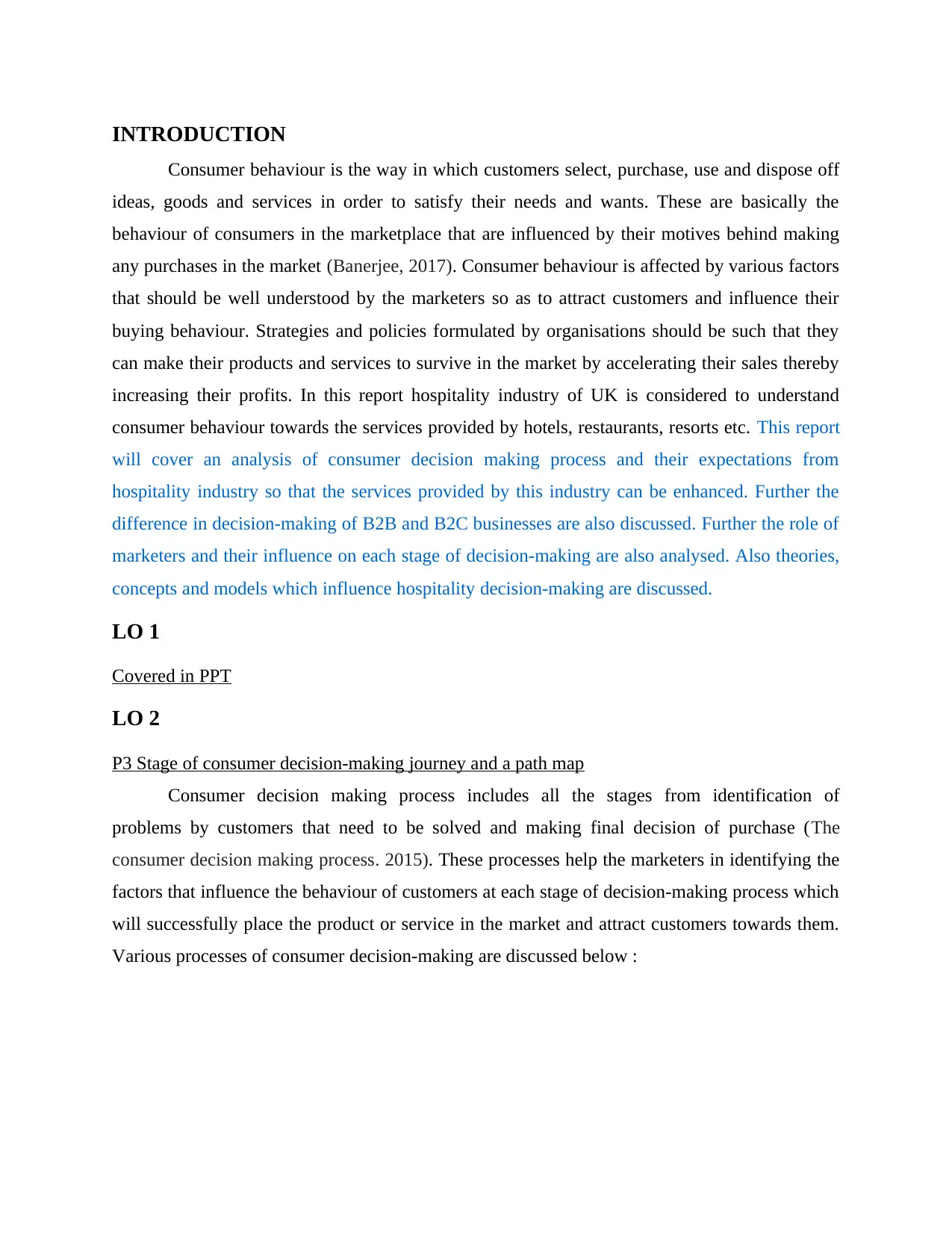
INTRODUCTION
Consumer behaviour is the way in which customers select, purchase, use and dispose off
ideas, goods and services in order to satisfy their needs and wants. These are basically the
behaviour of consumers in the marketplace that are influenced by their motives behind making
any purchases in the market (Banerjee, 2017). Consumer behaviour is affected by various factors
that should be well understood by the marketers so as to attract customers and influence their
buying behaviour. Strategies and policies formulated by organisations should be such that they
can make their products and services to survive in the market by accelerating their sales thereby
increasing their profits. In this report hospitality industry of UK is considered to understand
consumer behaviour towards the services provided by hotels, restaurants, resorts etc. This report
will cover an analysis of consumer decision making process and their expectations from
hospitality industry so that the services provided by this industry can be enhanced. Further the
difference in decision-making of B2B and B2C businesses are also discussed. Further the role of
marketers and their influence on each stage of decision-making are also analysed. Also theories,
concepts and models which influence hospitality decision-making are discussed.
LO 1
Covered in PPT
LO 2
P3 Stage of consumer decision-making journey and a path map
Consumer decision making process includes all the stages from identification of
problems by customers that need to be solved and making final decision of purchase (The
consumer decision making process. 2015). These processes help the marketers in identifying the
factors that influence the behaviour of customers at each stage of decision-making process which
will successfully place the product or service in the market and attract customers towards them.
Various processes of consumer decision-making are discussed below :
Consumer behaviour is the way in which customers select, purchase, use and dispose off
ideas, goods and services in order to satisfy their needs and wants. These are basically the
behaviour of consumers in the marketplace that are influenced by their motives behind making
any purchases in the market (Banerjee, 2017). Consumer behaviour is affected by various factors
that should be well understood by the marketers so as to attract customers and influence their
buying behaviour. Strategies and policies formulated by organisations should be such that they
can make their products and services to survive in the market by accelerating their sales thereby
increasing their profits. In this report hospitality industry of UK is considered to understand
consumer behaviour towards the services provided by hotels, restaurants, resorts etc. This report
will cover an analysis of consumer decision making process and their expectations from
hospitality industry so that the services provided by this industry can be enhanced. Further the
difference in decision-making of B2B and B2C businesses are also discussed. Further the role of
marketers and their influence on each stage of decision-making are also analysed. Also theories,
concepts and models which influence hospitality decision-making are discussed.
LO 1
Covered in PPT
LO 2
P3 Stage of consumer decision-making journey and a path map
Consumer decision making process includes all the stages from identification of
problems by customers that need to be solved and making final decision of purchase (The
consumer decision making process. 2015). These processes help the marketers in identifying the
factors that influence the behaviour of customers at each stage of decision-making process which
will successfully place the product or service in the market and attract customers towards them.
Various processes of consumer decision-making are discussed below :
⊘ This is a preview!⊘
Do you want full access?
Subscribe today to unlock all pages.

Trusted by 1+ million students worldwide
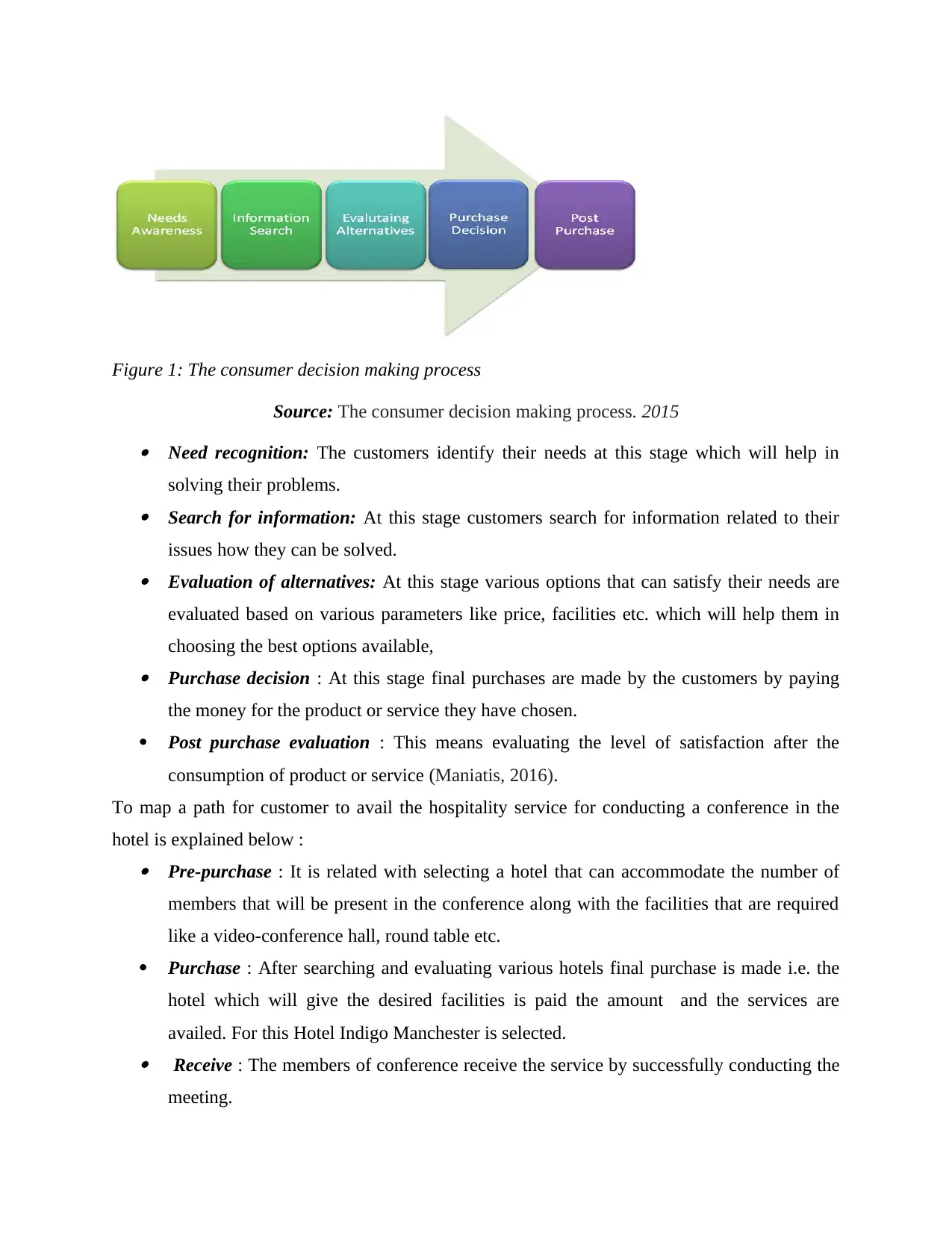
Figure 1: The consumer decision making process
Source: The consumer decision making process. 2015 Need recognition: The customers identify their needs at this stage which will help in
solving their problems. Search for information: At this stage customers search for information related to their
issues how they can be solved. Evaluation of alternatives: At this stage various options that can satisfy their needs are
evaluated based on various parameters like price, facilities etc. which will help them in
choosing the best options available, Purchase decision : At this stage final purchases are made by the customers by paying
the money for the product or service they have chosen.
Post purchase evaluation : This means evaluating the level of satisfaction after the
consumption of product or service (Maniatis, 2016).
To map a path for customer to avail the hospitality service for conducting a conference in the
hotel is explained below : Pre-purchase : It is related with selecting a hotel that can accommodate the number of
members that will be present in the conference along with the facilities that are required
like a video-conference hall, round table etc.
Purchase : After searching and evaluating various hotels final purchase is made i.e. the
hotel which will give the desired facilities is paid the amount and the services are
availed. For this Hotel Indigo Manchester is selected. Receive : The members of conference receive the service by successfully conducting the
meeting.
Source: The consumer decision making process. 2015 Need recognition: The customers identify their needs at this stage which will help in
solving their problems. Search for information: At this stage customers search for information related to their
issues how they can be solved. Evaluation of alternatives: At this stage various options that can satisfy their needs are
evaluated based on various parameters like price, facilities etc. which will help them in
choosing the best options available, Purchase decision : At this stage final purchases are made by the customers by paying
the money for the product or service they have chosen.
Post purchase evaluation : This means evaluating the level of satisfaction after the
consumption of product or service (Maniatis, 2016).
To map a path for customer to avail the hospitality service for conducting a conference in the
hotel is explained below : Pre-purchase : It is related with selecting a hotel that can accommodate the number of
members that will be present in the conference along with the facilities that are required
like a video-conference hall, round table etc.
Purchase : After searching and evaluating various hotels final purchase is made i.e. the
hotel which will give the desired facilities is paid the amount and the services are
availed. For this Hotel Indigo Manchester is selected. Receive : The members of conference receive the service by successfully conducting the
meeting.
Paraphrase This Document
Need a fresh take? Get an instant paraphrase of this document with our AI Paraphraser
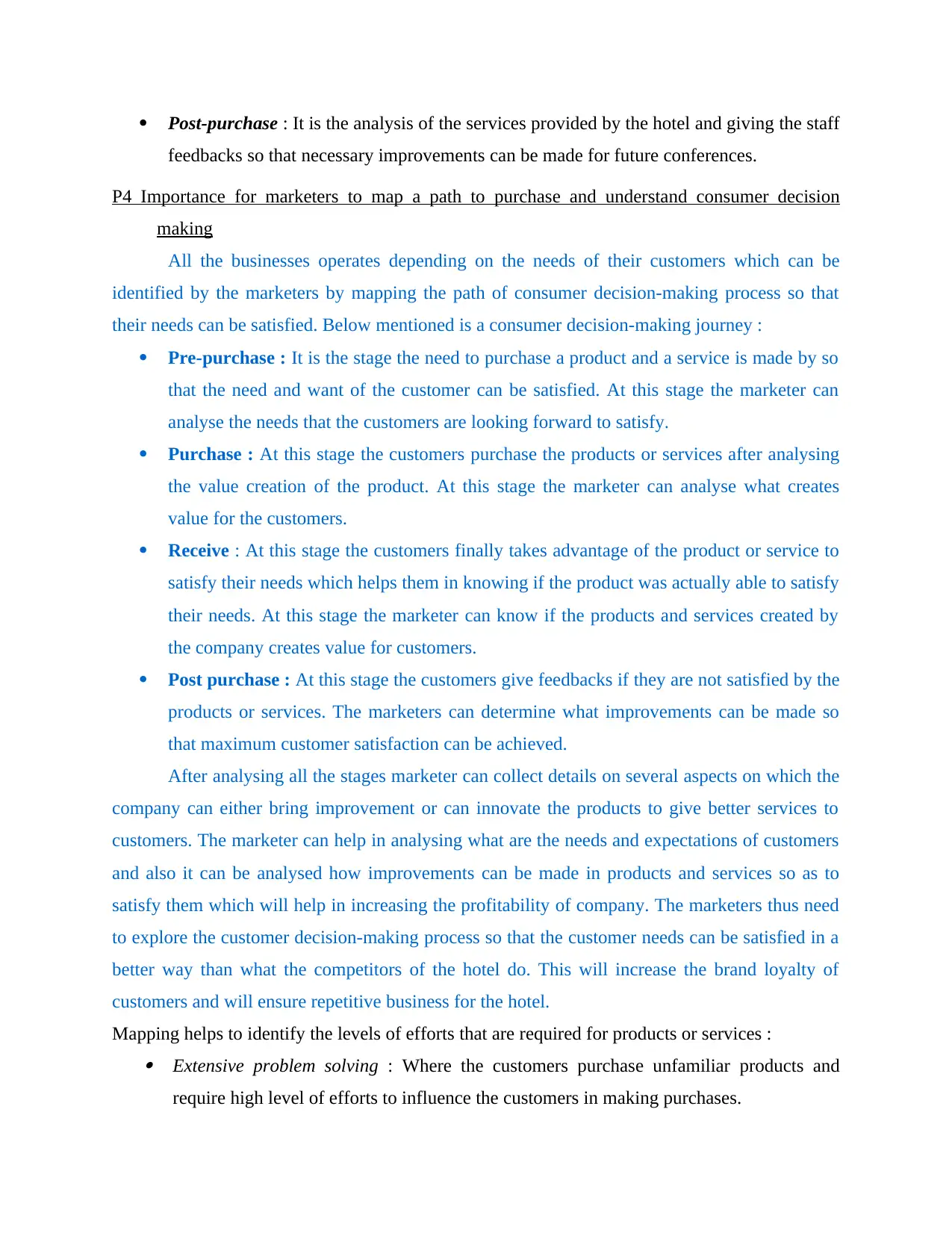
Post-purchase : It is the analysis of the services provided by the hotel and giving the staff
feedbacks so that necessary improvements can be made for future conferences.
P4 Importance for marketers to map a path to purchase and understand consumer decision
making
All the businesses operates depending on the needs of their customers which can be
identified by the marketers by mapping the path of consumer decision-making process so that
their needs can be satisfied. Below mentioned is a consumer decision-making journey :
Pre-purchase : It is the stage the need to purchase a product and a service is made by so
that the need and want of the customer can be satisfied. At this stage the marketer can
analyse the needs that the customers are looking forward to satisfy.
Purchase : At this stage the customers purchase the products or services after analysing
the value creation of the product. At this stage the marketer can analyse what creates
value for the customers.
Receive : At this stage the customers finally takes advantage of the product or service to
satisfy their needs which helps them in knowing if the product was actually able to satisfy
their needs. At this stage the marketer can know if the products and services created by
the company creates value for customers.
Post purchase : At this stage the customers give feedbacks if they are not satisfied by the
products or services. The marketers can determine what improvements can be made so
that maximum customer satisfaction can be achieved.
After analysing all the stages marketer can collect details on several aspects on which the
company can either bring improvement or can innovate the products to give better services to
customers. The marketer can help in analysing what are the needs and expectations of customers
and also it can be analysed how improvements can be made in products and services so as to
satisfy them which will help in increasing the profitability of company. The marketers thus need
to explore the customer decision-making process so that the customer needs can be satisfied in a
better way than what the competitors of the hotel do. This will increase the brand loyalty of
customers and will ensure repetitive business for the hotel.
Mapping helps to identify the levels of efforts that are required for products or services : Extensive problem solving : Where the customers purchase unfamiliar products and
require high level of efforts to influence the customers in making purchases.
feedbacks so that necessary improvements can be made for future conferences.
P4 Importance for marketers to map a path to purchase and understand consumer decision
making
All the businesses operates depending on the needs of their customers which can be
identified by the marketers by mapping the path of consumer decision-making process so that
their needs can be satisfied. Below mentioned is a consumer decision-making journey :
Pre-purchase : It is the stage the need to purchase a product and a service is made by so
that the need and want of the customer can be satisfied. At this stage the marketer can
analyse the needs that the customers are looking forward to satisfy.
Purchase : At this stage the customers purchase the products or services after analysing
the value creation of the product. At this stage the marketer can analyse what creates
value for the customers.
Receive : At this stage the customers finally takes advantage of the product or service to
satisfy their needs which helps them in knowing if the product was actually able to satisfy
their needs. At this stage the marketer can know if the products and services created by
the company creates value for customers.
Post purchase : At this stage the customers give feedbacks if they are not satisfied by the
products or services. The marketers can determine what improvements can be made so
that maximum customer satisfaction can be achieved.
After analysing all the stages marketer can collect details on several aspects on which the
company can either bring improvement or can innovate the products to give better services to
customers. The marketer can help in analysing what are the needs and expectations of customers
and also it can be analysed how improvements can be made in products and services so as to
satisfy them which will help in increasing the profitability of company. The marketers thus need
to explore the customer decision-making process so that the customer needs can be satisfied in a
better way than what the competitors of the hotel do. This will increase the brand loyalty of
customers and will ensure repetitive business for the hotel.
Mapping helps to identify the levels of efforts that are required for products or services : Extensive problem solving : Where the customers purchase unfamiliar products and
require high level of efforts to influence the customers in making purchases.
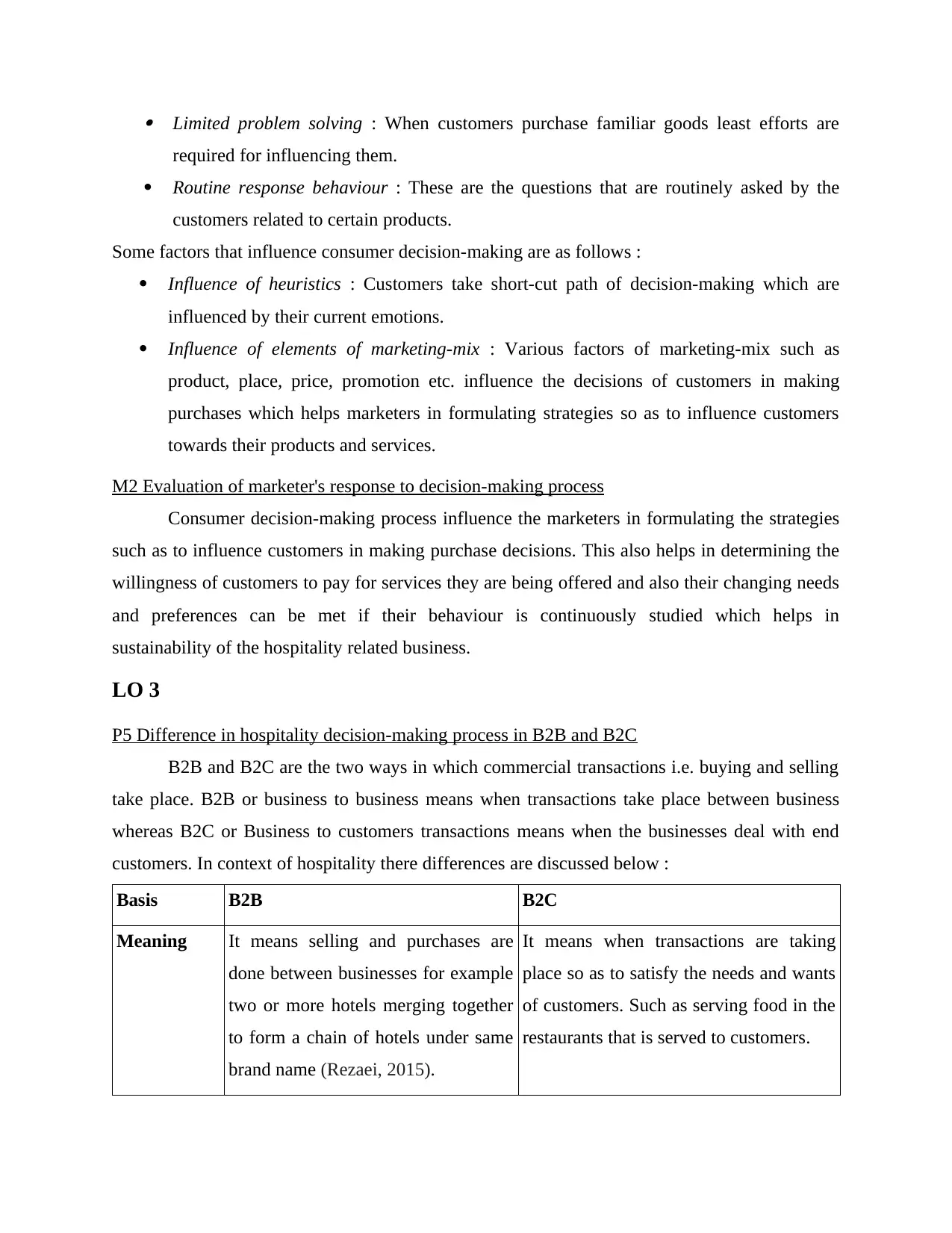
Limited problem solving : When customers purchase familiar goods least efforts are
required for influencing them.
Routine response behaviour : These are the questions that are routinely asked by the
customers related to certain products.
Some factors that influence consumer decision-making are as follows :
Influence of heuristics : Customers take short-cut path of decision-making which are
influenced by their current emotions.
Influence of elements of marketing-mix : Various factors of marketing-mix such as
product, place, price, promotion etc. influence the decisions of customers in making
purchases which helps marketers in formulating strategies so as to influence customers
towards their products and services.
M2 Evaluation of marketer's response to decision-making process
Consumer decision-making process influence the marketers in formulating the strategies
such as to influence customers in making purchase decisions. This also helps in determining the
willingness of customers to pay for services they are being offered and also their changing needs
and preferences can be met if their behaviour is continuously studied which helps in
sustainability of the hospitality related business.
LO 3
P5 Difference in hospitality decision-making process in B2B and B2C
B2B and B2C are the two ways in which commercial transactions i.e. buying and selling
take place. B2B or business to business means when transactions take place between business
whereas B2C or Business to customers transactions means when the businesses deal with end
customers. In context of hospitality there differences are discussed below :
Basis B2B B2C
Meaning It means selling and purchases are
done between businesses for example
two or more hotels merging together
to form a chain of hotels under same
brand name (Rezaei, 2015).
It means when transactions are taking
place so as to satisfy the needs and wants
of customers. Such as serving food in the
restaurants that is served to customers.
required for influencing them.
Routine response behaviour : These are the questions that are routinely asked by the
customers related to certain products.
Some factors that influence consumer decision-making are as follows :
Influence of heuristics : Customers take short-cut path of decision-making which are
influenced by their current emotions.
Influence of elements of marketing-mix : Various factors of marketing-mix such as
product, place, price, promotion etc. influence the decisions of customers in making
purchases which helps marketers in formulating strategies so as to influence customers
towards their products and services.
M2 Evaluation of marketer's response to decision-making process
Consumer decision-making process influence the marketers in formulating the strategies
such as to influence customers in making purchase decisions. This also helps in determining the
willingness of customers to pay for services they are being offered and also their changing needs
and preferences can be met if their behaviour is continuously studied which helps in
sustainability of the hospitality related business.
LO 3
P5 Difference in hospitality decision-making process in B2B and B2C
B2B and B2C are the two ways in which commercial transactions i.e. buying and selling
take place. B2B or business to business means when transactions take place between business
whereas B2C or Business to customers transactions means when the businesses deal with end
customers. In context of hospitality there differences are discussed below :
Basis B2B B2C
Meaning It means selling and purchases are
done between businesses for example
two or more hotels merging together
to form a chain of hotels under same
brand name (Rezaei, 2015).
It means when transactions are taking
place so as to satisfy the needs and wants
of customers. Such as serving food in the
restaurants that is served to customers.
⊘ This is a preview!⊘
Do you want full access?
Subscribe today to unlock all pages.

Trusted by 1+ million students worldwide
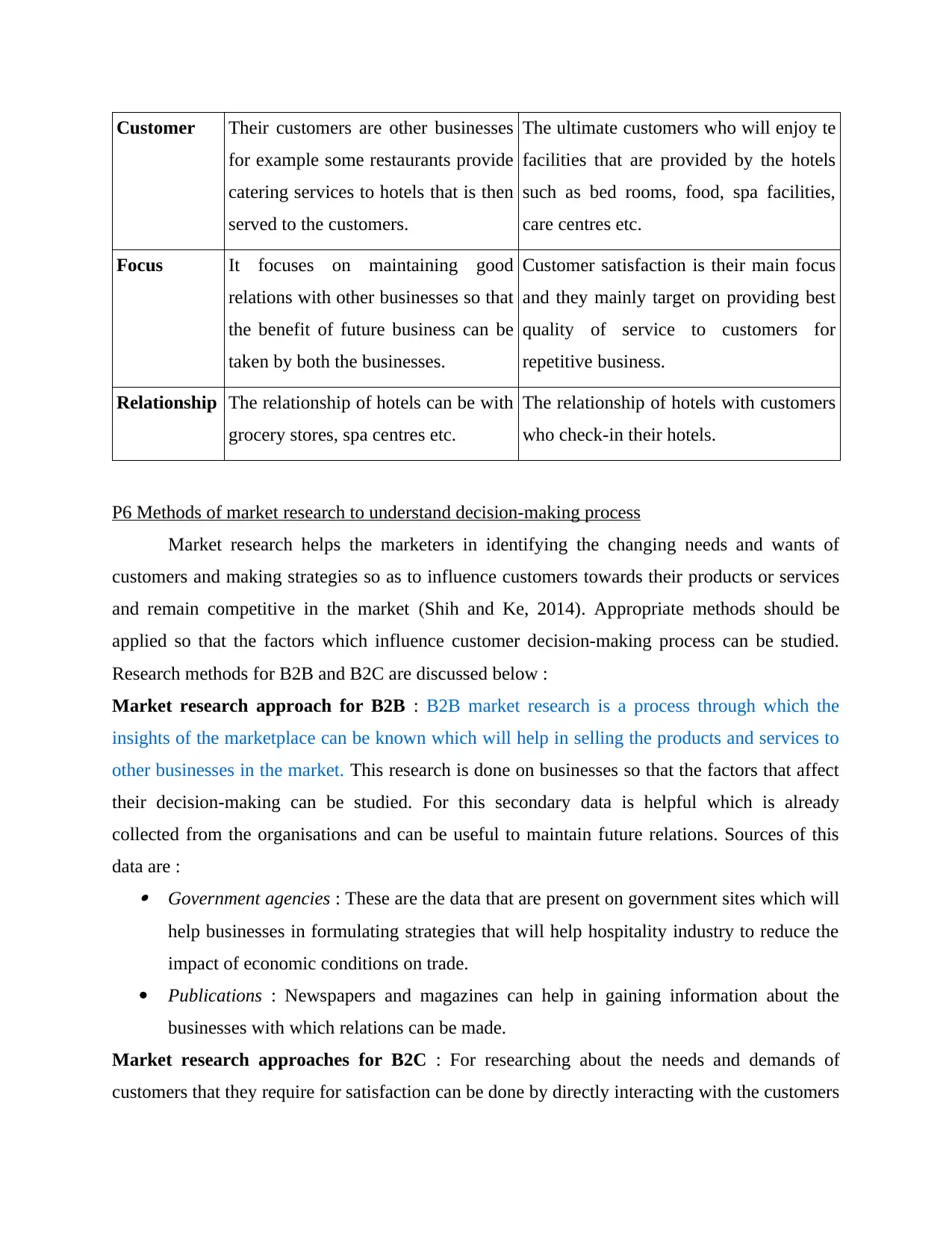
Customer Their customers are other businesses
for example some restaurants provide
catering services to hotels that is then
served to the customers.
The ultimate customers who will enjoy te
facilities that are provided by the hotels
such as bed rooms, food, spa facilities,
care centres etc.
Focus It focuses on maintaining good
relations with other businesses so that
the benefit of future business can be
taken by both the businesses.
Customer satisfaction is their main focus
and they mainly target on providing best
quality of service to customers for
repetitive business.
Relationship The relationship of hotels can be with
grocery stores, spa centres etc.
The relationship of hotels with customers
who check-in their hotels.
P6 Methods of market research to understand decision-making process
Market research helps the marketers in identifying the changing needs and wants of
customers and making strategies so as to influence customers towards their products or services
and remain competitive in the market (Shih and Ke, 2014). Appropriate methods should be
applied so that the factors which influence customer decision-making process can be studied.
Research methods for B2B and B2C are discussed below :
Market research approach for B2B : B2B market research is a process through which the
insights of the marketplace can be known which will help in selling the products and services to
other businesses in the market. This research is done on businesses so that the factors that affect
their decision-making can be studied. For this secondary data is helpful which is already
collected from the organisations and can be useful to maintain future relations. Sources of this
data are : Government agencies : These are the data that are present on government sites which will
help businesses in formulating strategies that will help hospitality industry to reduce the
impact of economic conditions on trade.
Publications : Newspapers and magazines can help in gaining information about the
businesses with which relations can be made.
Market research approaches for B2C : For researching about the needs and demands of
customers that they require for satisfaction can be done by directly interacting with the customers
for example some restaurants provide
catering services to hotels that is then
served to the customers.
The ultimate customers who will enjoy te
facilities that are provided by the hotels
such as bed rooms, food, spa facilities,
care centres etc.
Focus It focuses on maintaining good
relations with other businesses so that
the benefit of future business can be
taken by both the businesses.
Customer satisfaction is their main focus
and they mainly target on providing best
quality of service to customers for
repetitive business.
Relationship The relationship of hotels can be with
grocery stores, spa centres etc.
The relationship of hotels with customers
who check-in their hotels.
P6 Methods of market research to understand decision-making process
Market research helps the marketers in identifying the changing needs and wants of
customers and making strategies so as to influence customers towards their products or services
and remain competitive in the market (Shih and Ke, 2014). Appropriate methods should be
applied so that the factors which influence customer decision-making process can be studied.
Research methods for B2B and B2C are discussed below :
Market research approach for B2B : B2B market research is a process through which the
insights of the marketplace can be known which will help in selling the products and services to
other businesses in the market. This research is done on businesses so that the factors that affect
their decision-making can be studied. For this secondary data is helpful which is already
collected from the organisations and can be useful to maintain future relations. Sources of this
data are : Government agencies : These are the data that are present on government sites which will
help businesses in formulating strategies that will help hospitality industry to reduce the
impact of economic conditions on trade.
Publications : Newspapers and magazines can help in gaining information about the
businesses with which relations can be made.
Market research approaches for B2C : For researching about the needs and demands of
customers that they require for satisfaction can be done by directly interacting with the customers
Paraphrase This Document
Need a fresh take? Get an instant paraphrase of this document with our AI Paraphraser
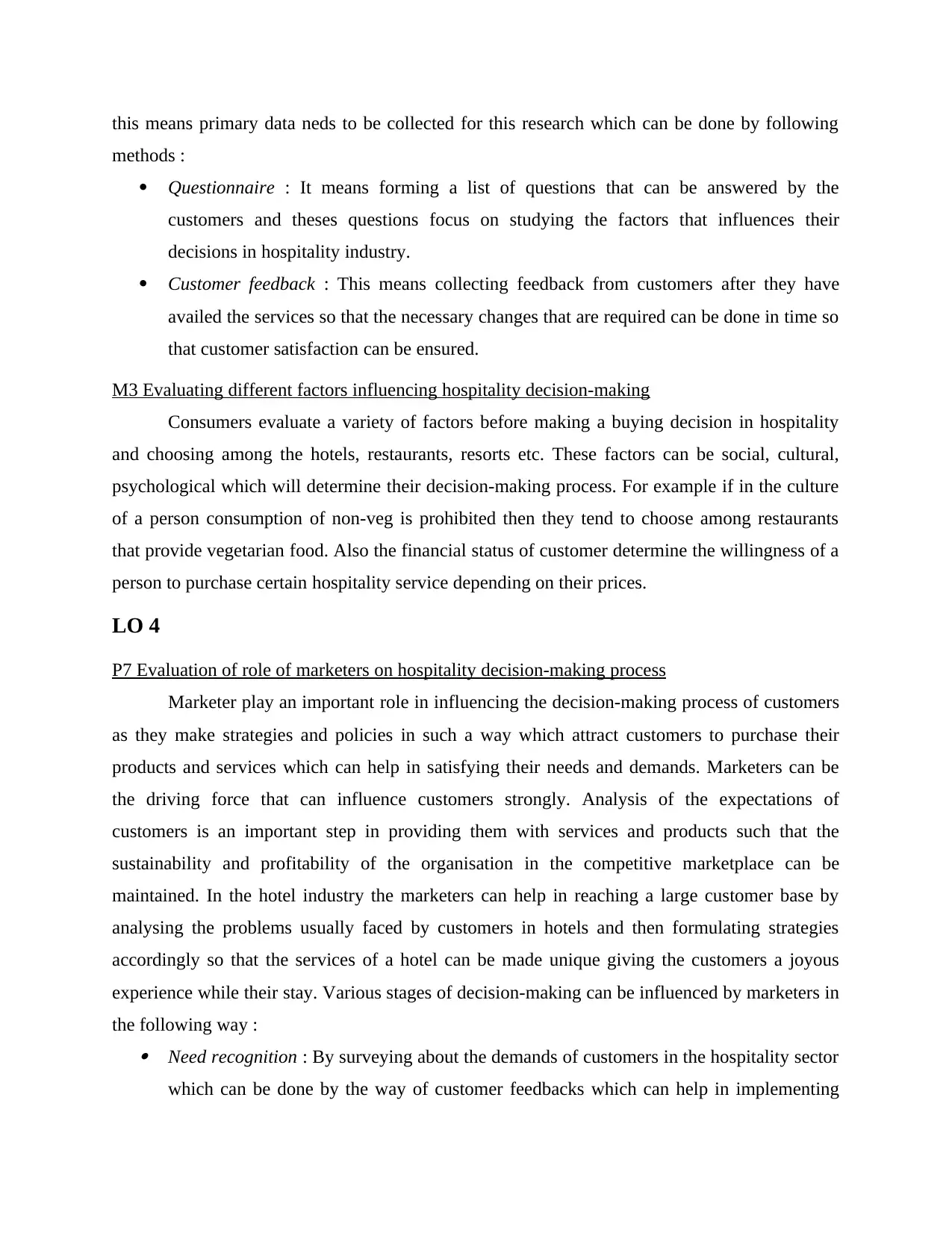
this means primary data neds to be collected for this research which can be done by following
methods :
Questionnaire : It means forming a list of questions that can be answered by the
customers and theses questions focus on studying the factors that influences their
decisions in hospitality industry.
Customer feedback : This means collecting feedback from customers after they have
availed the services so that the necessary changes that are required can be done in time so
that customer satisfaction can be ensured.
M3 Evaluating different factors influencing hospitality decision-making
Consumers evaluate a variety of factors before making a buying decision in hospitality
and choosing among the hotels, restaurants, resorts etc. These factors can be social, cultural,
psychological which will determine their decision-making process. For example if in the culture
of a person consumption of non-veg is prohibited then they tend to choose among restaurants
that provide vegetarian food. Also the financial status of customer determine the willingness of a
person to purchase certain hospitality service depending on their prices.
LO 4
P7 Evaluation of role of marketers on hospitality decision-making process
Marketer play an important role in influencing the decision-making process of customers
as they make strategies and policies in such a way which attract customers to purchase their
products and services which can help in satisfying their needs and demands. Marketers can be
the driving force that can influence customers strongly. Analysis of the expectations of
customers is an important step in providing them with services and products such that the
sustainability and profitability of the organisation in the competitive marketplace can be
maintained. In the hotel industry the marketers can help in reaching a large customer base by
analysing the problems usually faced by customers in hotels and then formulating strategies
accordingly so that the services of a hotel can be made unique giving the customers a joyous
experience while their stay. Various stages of decision-making can be influenced by marketers in
the following way : Need recognition : By surveying about the demands of customers in the hospitality sector
which can be done by the way of customer feedbacks which can help in implementing
methods :
Questionnaire : It means forming a list of questions that can be answered by the
customers and theses questions focus on studying the factors that influences their
decisions in hospitality industry.
Customer feedback : This means collecting feedback from customers after they have
availed the services so that the necessary changes that are required can be done in time so
that customer satisfaction can be ensured.
M3 Evaluating different factors influencing hospitality decision-making
Consumers evaluate a variety of factors before making a buying decision in hospitality
and choosing among the hotels, restaurants, resorts etc. These factors can be social, cultural,
psychological which will determine their decision-making process. For example if in the culture
of a person consumption of non-veg is prohibited then they tend to choose among restaurants
that provide vegetarian food. Also the financial status of customer determine the willingness of a
person to purchase certain hospitality service depending on their prices.
LO 4
P7 Evaluation of role of marketers on hospitality decision-making process
Marketer play an important role in influencing the decision-making process of customers
as they make strategies and policies in such a way which attract customers to purchase their
products and services which can help in satisfying their needs and demands. Marketers can be
the driving force that can influence customers strongly. Analysis of the expectations of
customers is an important step in providing them with services and products such that the
sustainability and profitability of the organisation in the competitive marketplace can be
maintained. In the hotel industry the marketers can help in reaching a large customer base by
analysing the problems usually faced by customers in hotels and then formulating strategies
accordingly so that the services of a hotel can be made unique giving the customers a joyous
experience while their stay. Various stages of decision-making can be influenced by marketers in
the following way : Need recognition : By surveying about the demands of customers in the hospitality sector
which can be done by the way of customer feedbacks which can help in implementing
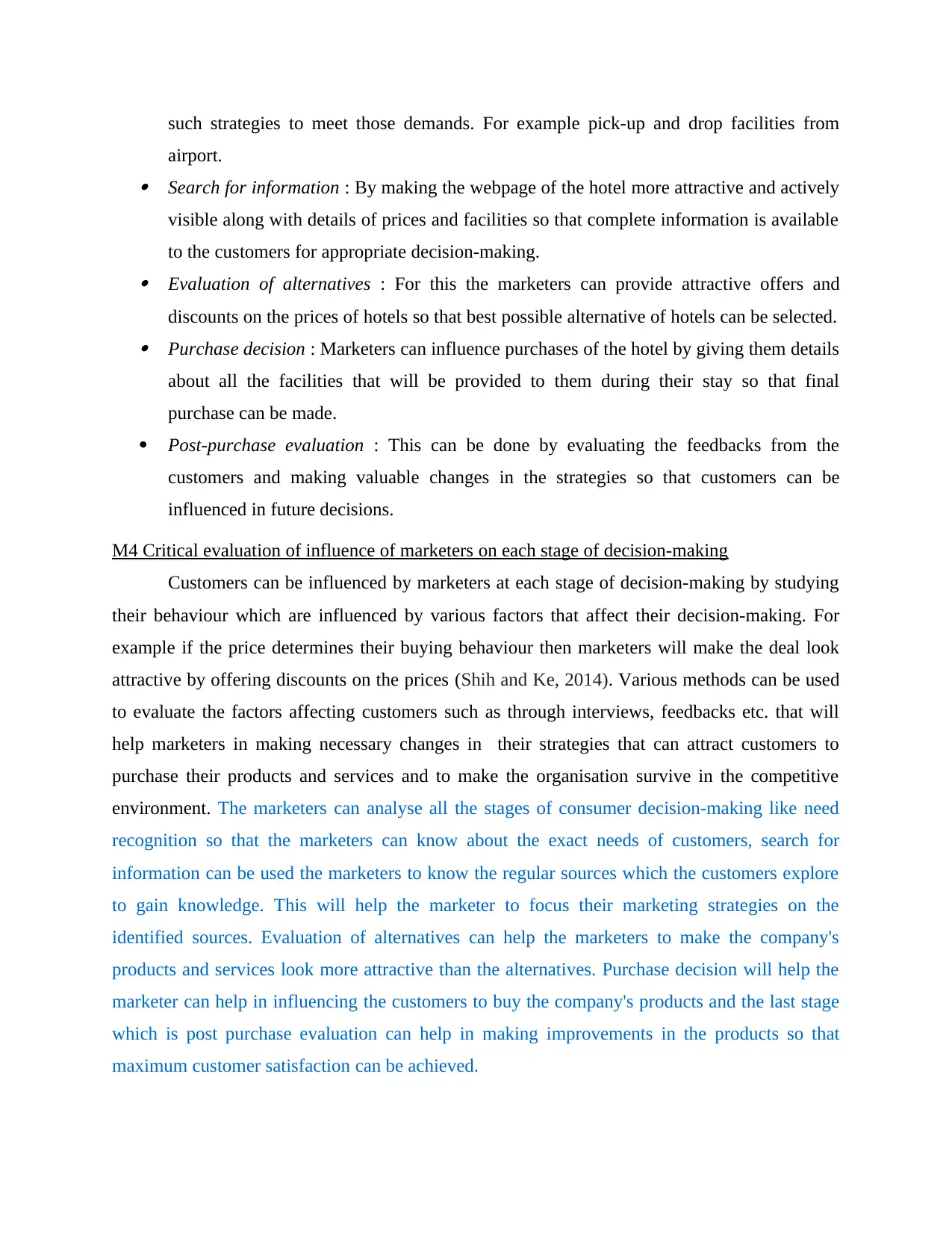
such strategies to meet those demands. For example pick-up and drop facilities from
airport. Search for information : By making the webpage of the hotel more attractive and actively
visible along with details of prices and facilities so that complete information is available
to the customers for appropriate decision-making. Evaluation of alternatives : For this the marketers can provide attractive offers and
discounts on the prices of hotels so that best possible alternative of hotels can be selected. Purchase decision : Marketers can influence purchases of the hotel by giving them details
about all the facilities that will be provided to them during their stay so that final
purchase can be made.
Post-purchase evaluation : This can be done by evaluating the feedbacks from the
customers and making valuable changes in the strategies so that customers can be
influenced in future decisions.
M4 Critical evaluation of influence of marketers on each stage of decision-making
Customers can be influenced by marketers at each stage of decision-making by studying
their behaviour which are influenced by various factors that affect their decision-making. For
example if the price determines their buying behaviour then marketers will make the deal look
attractive by offering discounts on the prices (Shih and Ke, 2014). Various methods can be used
to evaluate the factors affecting customers such as through interviews, feedbacks etc. that will
help marketers in making necessary changes in their strategies that can attract customers to
purchase their products and services and to make the organisation survive in the competitive
environment. The marketers can analyse all the stages of consumer decision-making like need
recognition so that the marketers can know about the exact needs of customers, search for
information can be used the marketers to know the regular sources which the customers explore
to gain knowledge. This will help the marketer to focus their marketing strategies on the
identified sources. Evaluation of alternatives can help the marketers to make the company's
products and services look more attractive than the alternatives. Purchase decision will help the
marketer can help in influencing the customers to buy the company's products and the last stage
which is post purchase evaluation can help in making improvements in the products so that
maximum customer satisfaction can be achieved.
airport. Search for information : By making the webpage of the hotel more attractive and actively
visible along with details of prices and facilities so that complete information is available
to the customers for appropriate decision-making. Evaluation of alternatives : For this the marketers can provide attractive offers and
discounts on the prices of hotels so that best possible alternative of hotels can be selected. Purchase decision : Marketers can influence purchases of the hotel by giving them details
about all the facilities that will be provided to them during their stay so that final
purchase can be made.
Post-purchase evaluation : This can be done by evaluating the feedbacks from the
customers and making valuable changes in the strategies so that customers can be
influenced in future decisions.
M4 Critical evaluation of influence of marketers on each stage of decision-making
Customers can be influenced by marketers at each stage of decision-making by studying
their behaviour which are influenced by various factors that affect their decision-making. For
example if the price determines their buying behaviour then marketers will make the deal look
attractive by offering discounts on the prices (Shih and Ke, 2014). Various methods can be used
to evaluate the factors affecting customers such as through interviews, feedbacks etc. that will
help marketers in making necessary changes in their strategies that can attract customers to
purchase their products and services and to make the organisation survive in the competitive
environment. The marketers can analyse all the stages of consumer decision-making like need
recognition so that the marketers can know about the exact needs of customers, search for
information can be used the marketers to know the regular sources which the customers explore
to gain knowledge. This will help the marketer to focus their marketing strategies on the
identified sources. Evaluation of alternatives can help the marketers to make the company's
products and services look more attractive than the alternatives. Purchase decision will help the
marketer can help in influencing the customers to buy the company's products and the last stage
which is post purchase evaluation can help in making improvements in the products so that
maximum customer satisfaction can be achieved.
⊘ This is a preview!⊘
Do you want full access?
Subscribe today to unlock all pages.

Trusted by 1+ million students worldwide
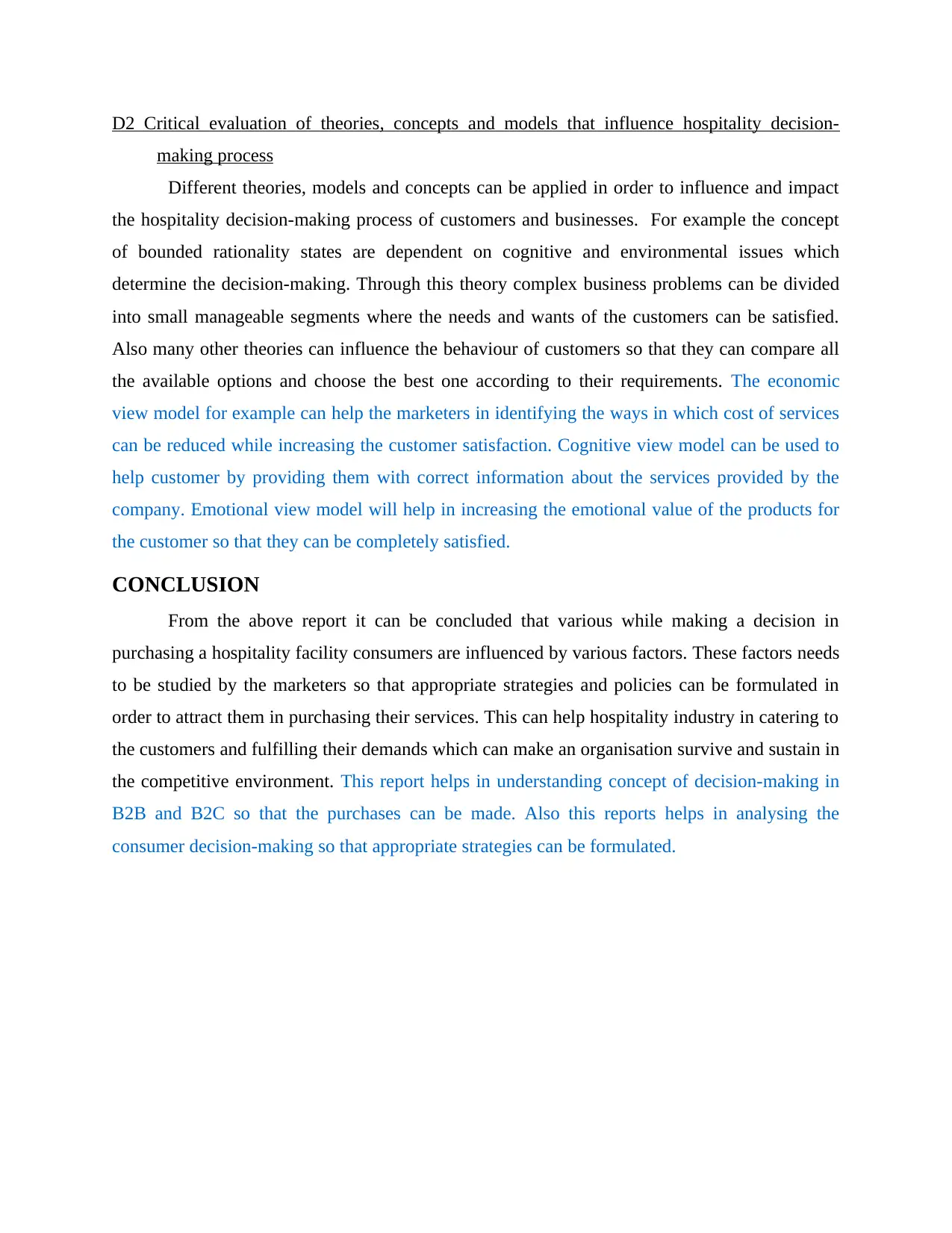
D2 Critical evaluation of theories, concepts and models that influence hospitality decision-
making process
Different theories, models and concepts can be applied in order to influence and impact
the hospitality decision-making process of customers and businesses. For example the concept
of bounded rationality states are dependent on cognitive and environmental issues which
determine the decision-making. Through this theory complex business problems can be divided
into small manageable segments where the needs and wants of the customers can be satisfied.
Also many other theories can influence the behaviour of customers so that they can compare all
the available options and choose the best one according to their requirements. The economic
view model for example can help the marketers in identifying the ways in which cost of services
can be reduced while increasing the customer satisfaction. Cognitive view model can be used to
help customer by providing them with correct information about the services provided by the
company. Emotional view model will help in increasing the emotional value of the products for
the customer so that they can be completely satisfied.
CONCLUSION
From the above report it can be concluded that various while making a decision in
purchasing a hospitality facility consumers are influenced by various factors. These factors needs
to be studied by the marketers so that appropriate strategies and policies can be formulated in
order to attract them in purchasing their services. This can help hospitality industry in catering to
the customers and fulfilling their demands which can make an organisation survive and sustain in
the competitive environment. This report helps in understanding concept of decision-making in
B2B and B2C so that the purchases can be made. Also this reports helps in analysing the
consumer decision-making so that appropriate strategies can be formulated.
making process
Different theories, models and concepts can be applied in order to influence and impact
the hospitality decision-making process of customers and businesses. For example the concept
of bounded rationality states are dependent on cognitive and environmental issues which
determine the decision-making. Through this theory complex business problems can be divided
into small manageable segments where the needs and wants of the customers can be satisfied.
Also many other theories can influence the behaviour of customers so that they can compare all
the available options and choose the best one according to their requirements. The economic
view model for example can help the marketers in identifying the ways in which cost of services
can be reduced while increasing the customer satisfaction. Cognitive view model can be used to
help customer by providing them with correct information about the services provided by the
company. Emotional view model will help in increasing the emotional value of the products for
the customer so that they can be completely satisfied.
CONCLUSION
From the above report it can be concluded that various while making a decision in
purchasing a hospitality facility consumers are influenced by various factors. These factors needs
to be studied by the marketers so that appropriate strategies and policies can be formulated in
order to attract them in purchasing their services. This can help hospitality industry in catering to
the customers and fulfilling their demands which can make an organisation survive and sustain in
the competitive environment. This report helps in understanding concept of decision-making in
B2B and B2C so that the purchases can be made. Also this reports helps in analysing the
consumer decision-making so that appropriate strategies can be formulated.
Paraphrase This Document
Need a fresh take? Get an instant paraphrase of this document with our AI Paraphraser
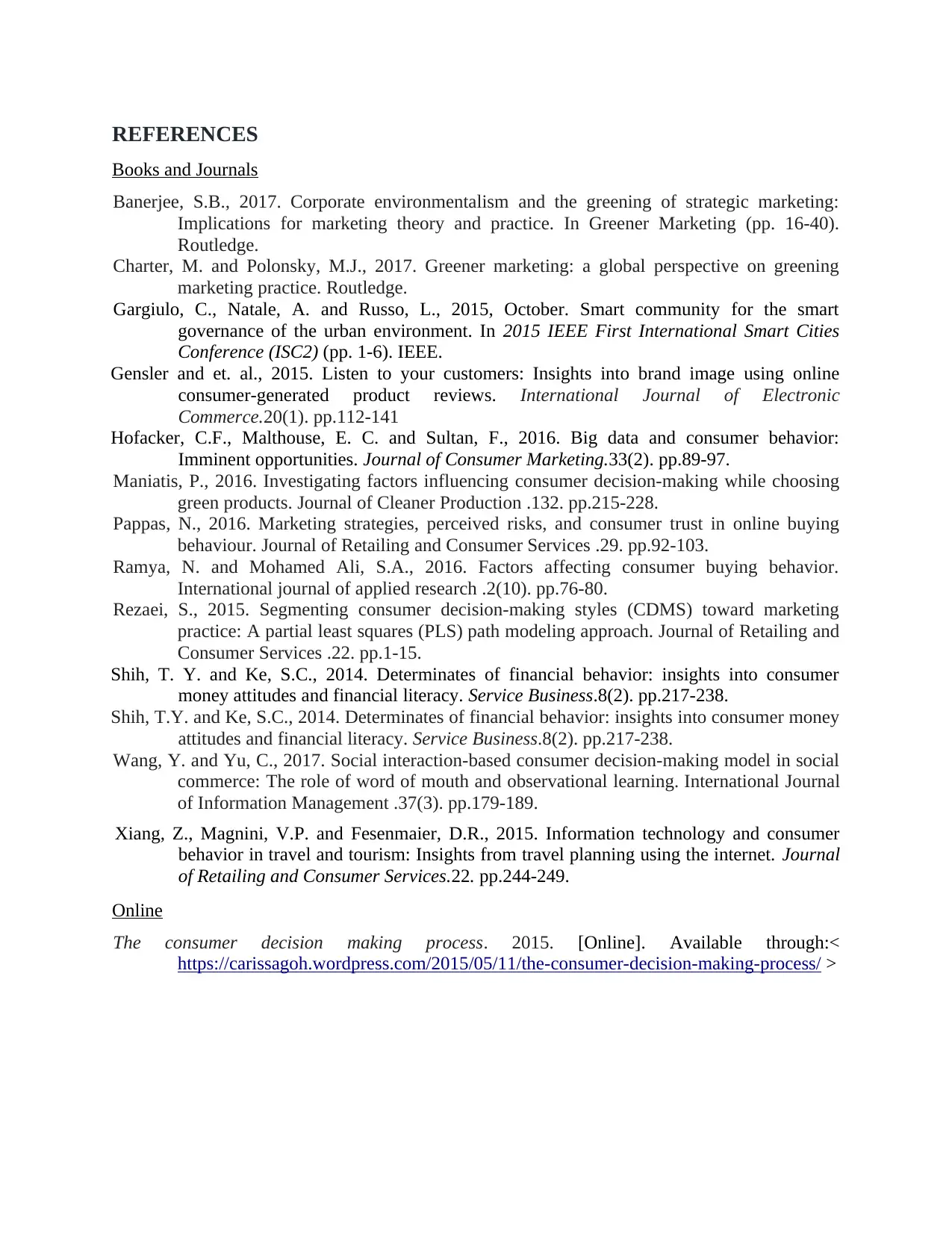
REFERENCES
Books and Journals
Banerjee, S.B., 2017. Corporate environmentalism and the greening of strategic marketing:
Implications for marketing theory and practice. In Greener Marketing (pp. 16-40).
Routledge.
Charter, M. and Polonsky, M.J., 2017. Greener marketing: a global perspective on greening
marketing practice. Routledge.
Gargiulo, C., Natale, A. and Russo, L., 2015, October. Smart community for the smart
governance of the urban environment. In 2015 IEEE First International Smart Cities
Conference (ISC2) (pp. 1-6). IEEE.
Gensler and et. al., 2015. Listen to your customers: Insights into brand image using online
consumer-generated product reviews. International Journal of Electronic
Commerce.20(1). pp.112-141
Hofacker, C.F., Malthouse, E. C. and Sultan, F., 2016. Big data and consumer behavior:
Imminent opportunities. Journal of Consumer Marketing.33(2). pp.89-97.
Maniatis, P., 2016. Investigating factors influencing consumer decision-making while choosing
green products. Journal of Cleaner Production .132. pp.215-228.
Pappas, N., 2016. Marketing strategies, perceived risks, and consumer trust in online buying
behaviour. Journal of Retailing and Consumer Services .29. pp.92-103.
Ramya, N. and Mohamed Ali, S.A., 2016. Factors affecting consumer buying behavior.
International journal of applied research .2(10). pp.76-80.
Rezaei, S., 2015. Segmenting consumer decision-making styles (CDMS) toward marketing
practice: A partial least squares (PLS) path modeling approach. Journal of Retailing and
Consumer Services .22. pp.1-15.
Shih, T. Y. and Ke, S.C., 2014. Determinates of financial behavior: insights into consumer
money attitudes and financial literacy. Service Business.8(2). pp.217-238.
Shih, T.Y. and Ke, S.C., 2014. Determinates of financial behavior: insights into consumer money
attitudes and financial literacy. Service Business.8(2). pp.217-238.
Wang, Y. and Yu, C., 2017. Social interaction-based consumer decision-making model in social
commerce: The role of word of mouth and observational learning. International Journal
of Information Management .37(3). pp.179-189.
Xiang, Z., Magnini, V.P. and Fesenmaier, D.R., 2015. Information technology and consumer
behavior in travel and tourism: Insights from travel planning using the internet. Journal
of Retailing and Consumer Services.22. pp.244-249.
Online
The consumer decision making process. 2015. [Online]. Available through:<
https://carissagoh.wordpress.com/2015/05/11/the-consumer-decision-making-process/ >
Books and Journals
Banerjee, S.B., 2017. Corporate environmentalism and the greening of strategic marketing:
Implications for marketing theory and practice. In Greener Marketing (pp. 16-40).
Routledge.
Charter, M. and Polonsky, M.J., 2017. Greener marketing: a global perspective on greening
marketing practice. Routledge.
Gargiulo, C., Natale, A. and Russo, L., 2015, October. Smart community for the smart
governance of the urban environment. In 2015 IEEE First International Smart Cities
Conference (ISC2) (pp. 1-6). IEEE.
Gensler and et. al., 2015. Listen to your customers: Insights into brand image using online
consumer-generated product reviews. International Journal of Electronic
Commerce.20(1). pp.112-141
Hofacker, C.F., Malthouse, E. C. and Sultan, F., 2016. Big data and consumer behavior:
Imminent opportunities. Journal of Consumer Marketing.33(2). pp.89-97.
Maniatis, P., 2016. Investigating factors influencing consumer decision-making while choosing
green products. Journal of Cleaner Production .132. pp.215-228.
Pappas, N., 2016. Marketing strategies, perceived risks, and consumer trust in online buying
behaviour. Journal of Retailing and Consumer Services .29. pp.92-103.
Ramya, N. and Mohamed Ali, S.A., 2016. Factors affecting consumer buying behavior.
International journal of applied research .2(10). pp.76-80.
Rezaei, S., 2015. Segmenting consumer decision-making styles (CDMS) toward marketing
practice: A partial least squares (PLS) path modeling approach. Journal of Retailing and
Consumer Services .22. pp.1-15.
Shih, T. Y. and Ke, S.C., 2014. Determinates of financial behavior: insights into consumer
money attitudes and financial literacy. Service Business.8(2). pp.217-238.
Shih, T.Y. and Ke, S.C., 2014. Determinates of financial behavior: insights into consumer money
attitudes and financial literacy. Service Business.8(2). pp.217-238.
Wang, Y. and Yu, C., 2017. Social interaction-based consumer decision-making model in social
commerce: The role of word of mouth and observational learning. International Journal
of Information Management .37(3). pp.179-189.
Xiang, Z., Magnini, V.P. and Fesenmaier, D.R., 2015. Information technology and consumer
behavior in travel and tourism: Insights from travel planning using the internet. Journal
of Retailing and Consumer Services.22. pp.244-249.
Online
The consumer decision making process. 2015. [Online]. Available through:<
https://carissagoh.wordpress.com/2015/05/11/the-consumer-decision-making-process/ >

⊘ This is a preview!⊘
Do you want full access?
Subscribe today to unlock all pages.

Trusted by 1+ million students worldwide
1 out of 12
Related Documents
Your All-in-One AI-Powered Toolkit for Academic Success.
+13062052269
info@desklib.com
Available 24*7 on WhatsApp / Email
![[object Object]](/_next/static/media/star-bottom.7253800d.svg)
Unlock your academic potential
Copyright © 2020–2025 A2Z Services. All Rights Reserved. Developed and managed by ZUCOL.





